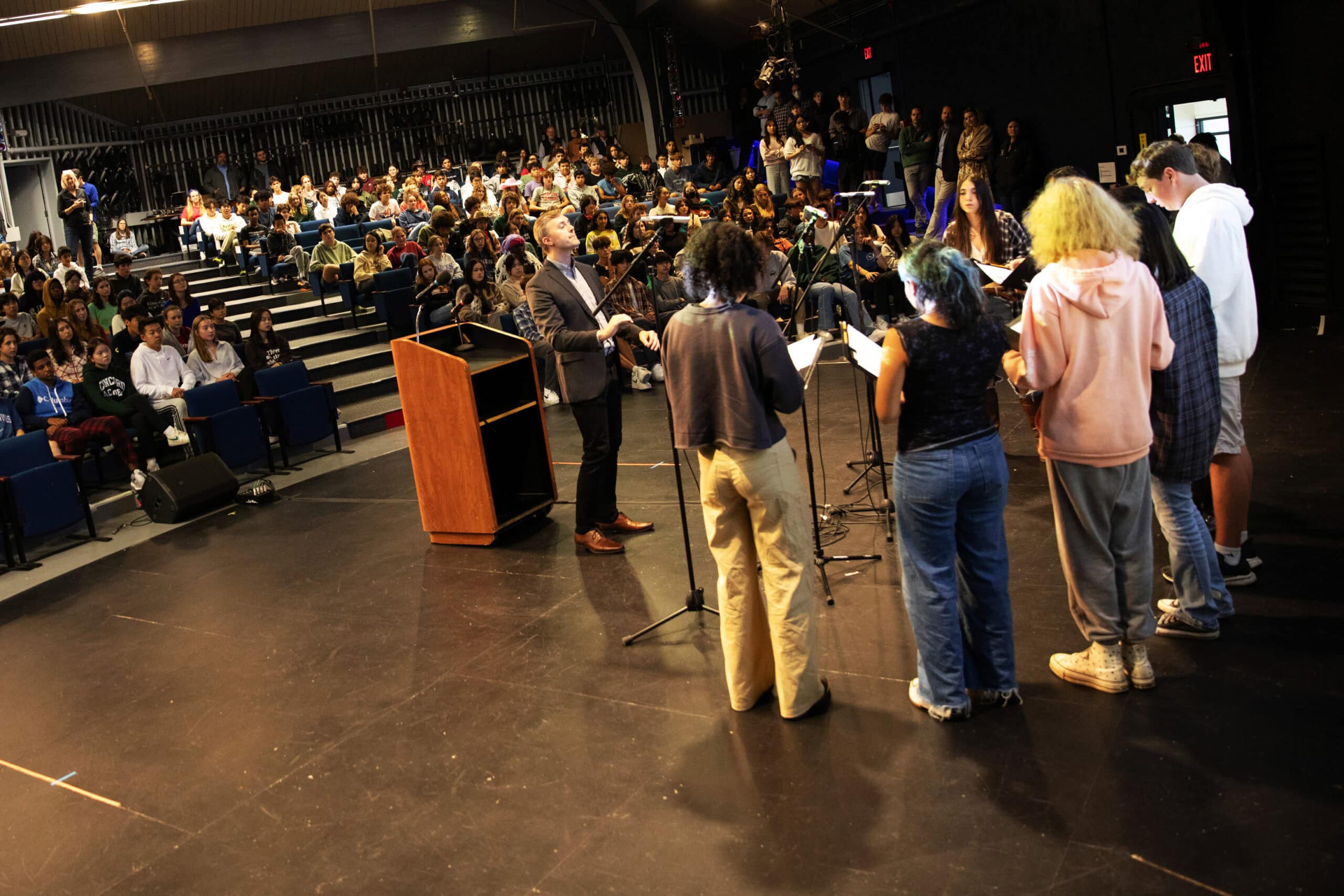CA’s Production of Radium Girls Shines a Bright Light on a Difficult History

Concord Academy’s fall mainstage production of Radium Girls lit up the Performing Arts Center during three performances over Family Weekend on October 25 and 26, 2024. Set in the 1920s and based closely on historical events, the one-act production invited CA audiences to consider notions of progress and responsibility during an era predating workplace safety regulations.
While the scientific discovery of radium was being rapidly commercialized and marketed as a miracle in skin creams and health tonics, the U.S. Radium Corporation stood to make a profit from its radioluminescent paint. But the watch dial painters the company employed, young working-class girls who had been eager to do detailed handwork that had an aura of elegance about it, begin to fall mysteriously ill. One of them, the play’s sympathetic heroine, Grace Fryer (Lira Schwab ’26), chose to seek justice through the courts—and in the media.
In CA’s production, the drama unfolded against a stark and versatile set designed by multidisciplinary CA faculty member Jessica Cloutier-Plasse. Its massive illuminating clock face and severe columns lent an air of increasing menace to a stage that was alternately sickroom and courtroom, doctor’s office and factory floor.
The performances of William Jiang-Fogel ’27, who played the business executive Arthur Roeder, and Grace Goodman ’27 as Dr. Von Sochocky, Roeder’s inventor partner, lent complexity to the drama. As Jiang-Fogel portrayed him, Roeder is haunted by his complicity, which he experiences as a business imperative, forced by his duty to shareholders. Von Sochocky, who would eventually die from his exposure to radium, knew the element could destroy living tissue and had taken a calculated risk; in contrast, the dial painters aren’t aware of the danger of their work. Their insistence on connecting the dots meets with denial and condescension. “Listen to science,” they’re lectured.
Before the first performance, a pre-show talk gathered guest director Elaine Vaan Hogue; Michael Bennett, Linda Coyne Lloyd Chair 0f Performing Arts; Will Tucker, head of the Science Department; and history teacher Claire Nelson. Vaan Hogue said she and the actors had many discussions about the power dynamics within the play. “So much came up in our initial reading and rehearsals,” she said. “The students were so insightful, inquisitive, and smart.” Inspired to learn more about “this shameful part of our history,” Vaan Hogue said, one of the actors even created an in-depth dramaturgy packet.
Bennett discussed the contemporary relevance of the play—one of two this season set a century ago (Chicago will be the winter musical). In planning performing arts seasons, his department often thinks “about what’s going on in the world that we’re trying to illuminate and speak to,” he said. “We try to pick pieces that have material that the students can really sink their teeth into and think deeply and academically about,” he said, particularly in conjunction with CA’s many interdisciplinary and cross-disciplinary courses.
Tucker is currently teaching We Didn’t Start the Fire: Chemistry in the Short 20th Century, a cross-listed science and history class that focuses on chemistry during the Cold War. Today’s understanding of radiation as dangerous is a historical development, Tucker explained: “We live in an era post-deployment of nuclear weapons; we live in an era that is shaped by radioactivity and nuclear chemisty.” In the 1920s, radioactivity had only been known for about 30 years, and was still greeted as “a novelty”—as a “weird power that comes from rocks” with immense potential, he said, which also “helped us unlock how atoms are structured.” The rush to commodify scientific discovery, “to take advantage of scientific knowledge for our own ends,” he added, is an important historical context to understand, as is the rise of fascism and militarism in the 1930s, leading up to World War II. “In the history of chemistry, what if this had been discovered 20 years later or 20 years earlier—would we think of nuclear technology as a weapon of war?” he asked.
Nelson discussed the history of labor organizing, drawing a contemporary parallel to the 1920s as an era of possibility unlocked by the mingling of science and business—also an era when “business could do no wrong.” The Food and Drug Administration had been created in 1906, she said, in response to Upton Sinclair’s exposé The Jungle, but its purpose was to protect consumers more than laborers; no real labor protection was instituted until the New Deal. Nelson emphasized women’s role on the “leading edge of activism” that eventually led to “a rise in consciousness of the need for regulation and protections.”
Circling back to the play, Vaan Hogue said she had known little of this history before directing the two-act version of Radium Girls a decade ago. Together with the company that performed it, she said she found great value in educating herself on the historical context of this particular narrative. “It’s been the same with these students,” Vaan Hogue said, reflecting on her process at CA. “Doing theater is an act of activism.”





